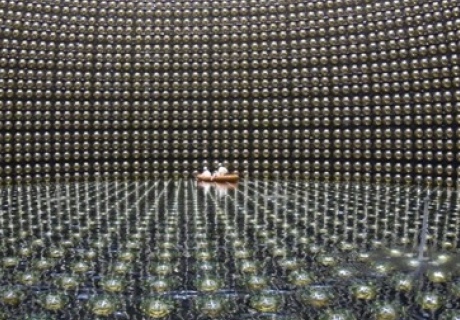
Latest results from the T2K experiment in Japan

New research has shown that subatomic particles called neutrinos have a previously unseen identity-shifting property.
The results confirm early indications that neutrinos change between different types, or oscillate, in three ways where they had previously only been seen oscillating in two ways.
Scientists from the T2K collaboration, which involves Dr Yoshi Uchida and Dr Morgan Wascko from Imperial's Department of Physics, made the announcement at a meeting of the European Physical Society in Stockholm, today.
Following the new findings, the researchers are keen to explore whether neutrinos oscillate in a different way to their antimatter particles (called anti-neutrinos). Equal amounts of matter and antimatter were thought to have existed at the start of the universe but now everything that we know is made of ordinary matter.
If any such differences between neutrinos and anti-neutrinos can be found, this will help scientists explain how all the antimatter has disappeared from the universe, leaving only ordinary matter.
Schrodinger and Heisenberg never imagined seeing this kind of thing!
– Dr Morgan Wascko
Department of Physics
There are three types, or 'flavours,' of neutrinos – one paired with the electron (called the electron neutrino), and two more paired with the electron's heavier cousins, the muon and tau leptons (called the muon and tau neutrinos).
The three different flavours of neutrinos can spontaneously change into each other, a phenomenon called neutrino oscillation. Interchanges between muon and tau neutrinos, and between tau and electron neutrinos have been confirmed by other experiments, but until now the third way had not been seen.
To explore the neutrinos’ oscillations, the T2K experiment fired a beam of neutrinos from the J-PARC laboratory at Tokai Village on the eastern coast of Japan, and detected them at the Super-Kamiokande neutrino detector, 295 km away in the mountains of the north-western part of the country. Here, the scientists looked to see if the neutrinos at the end of the beam matched those emitted at the start.
In the new data, they found 28 electron neutrinos appearing in the beam of muon neutrinos, where they only expected to see an average of between four and five, which indicated evidence for the third type of oscillation.
In 2011 when early data was released, the scientists had only observed six instances of electron-muon oscillation. Now the team say they have enough evidence to confirm they have observed neutrinos oscillating in every way they expect to be possible.
Imperial physicist, Dr Yoshi Uchida, said: "Using huge volumes of data collected at the T2K experiment, we have been able to check and cross-check the results of our neutrino experiments, and are now ready to make a statement that stands up to scientific scrutiny. What was a strong indication in 2011 of a phenomenon that had never been seen before is now essentially irrefutable."

Physicists working inside the Super Kamiokande neutrino detector in Japan
T2K scientists have observed oscillations from muon neutrinos to electron neutrinos, which is one of the experiment's main aims. These oscillations are called 'electron neutrino appearance' since the electron neutrinos appear in a beam of muon neutrinos. These findings will be compared to future data with anti-neutrinos to test whether muon and electron neutrinos oscillate in a different manner to their antimatter counterparts, an asymmetry that could help explain why antimatter is so comparatively rare.
"The exciting thing is that electron neutrino appearance, combined with other neutrino experiments, can help us understand whether there is a significant matter-antimatter asymmetry in neutrinos," Dr Uchida continued.
"The question now is, do the observations from different experiments fit together in a way that seems consistent - and does it help us understand more about the universe."
The Science and Technology Facilities Council (STFC) is the UK sponsor of particle physics and supports the universities involved in the T2K experiment.
Supporters

Article text (excluding photos or graphics) available under an Attribution-NonCommercial-ShareAlike Creative Commons license.
Photos and graphics subject to third party copyright used with permission or © Imperial College London.
Reporter
Simon Levey
Communications Division

Contact details
Email: s.levey@imperial.ac.uk
Show all stories by this author
Leave a comment
Your comment may be published, displaying your name as you provide it, unless you request otherwise. Your contact details will never be published.




Comments
Comments are loading...